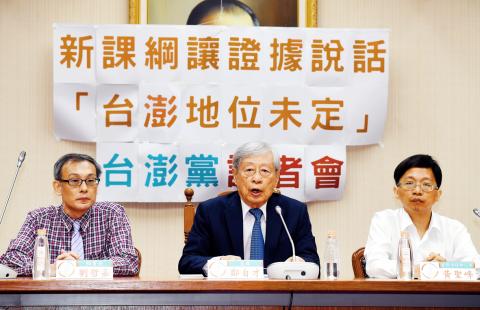Taiwanese must discard the imposed colonial regime of the Republic of China (ROC) and establish a state of “Taiwan” that can protect the nation from Chinese invasion, Sovereign State for Formosa and the Pescadores Party Chairman Cheng Tzu-tsai (鄭自才) said on Monday.
He had to speak up on the issue of Taiwanese sovereignty and Taiwan’s international status after former president Ma Ying-jeou (馬英九) and several pro-China academics wrote about disputes in school textbooks dealing with Taiwan’s history, Cheng said.
“It is a fact that Taiwan remains under its ‘undetermined status,’ which is well-known in the international community,” Cheng told a seminar at the Legislative Yuan in Taipei.

Photo: CNA
“The allies after World War II did not ‘return’ Taiwan to be ruled by Chiang Kai-shek’s (蔣介石) Chinese Nationalist Party [KMT] regime. It was a fabrication about the KMT’s claim over Taiwan’s retrocession to China,” he said.
The best recourse for residents of Taiwan and the Penghu Islands is to follow the international accords in the post-World War II period on decolonization, and hold a plebiscite on self-determination to achieve statehood, as had happened in many countries in Asia, Africa, Latin America and the Pacific, Cheng said.
Ma and pro-China academics have written letters criticizing two publishing houses over textbooks that mention the “undetermined status of Taiwan,” which Ma said was “nonsense.”
Cheng provided photocopied materials and historic documents from US and other nations to support his claim that the Allies had only given temporary custody of Taiwan and Penghu to the KMT regime, while the legal status was not spelled out, and the residents have the right to a plebiscite for self-determination.
He said that Japan signed the 1951 San Francisco Treaty only renouncing all right, title, and claim to Taiwan and Penghu without explicitly deciding on the sovereignty status of the two territories.
Taiwan historian Huang Sheng-feng (黃聖峰) said that many Taiwanese independence advocates are unhappy with the stance taken by the Democratic Progressive Party (DPP) and President Tsai Ing-wen (蔡英文) of maintaining the “status quo” by upholding the ROC political framework, which would mean Beijing can lay claim to Taiwan and the Penghu Islands.
“The best recourse is to follow the international laws and conduct a plebiscite for self-determination, by which the people of Taiwan and Penghu can declare to the world their decision to become a new Taiwan nation. This is the way for us to achieve statehood, and deter military invasion and annexation by China,” Huang said.
Cheng, 82, is a senior figure in the Taiwanese independence movement.

SHIPS, TRAINS AND AUTOMOBILES: The ministry has announced changes to varied transportation industries taking effect soon, with a number of effects for passengers Beginning next month, the post office is canceling signature upon delivery and written inquiry services for international registered small packets in accordance with the new policy of the Universal Postal Union, the Ministry of Transportation and Communications said yesterday. The new policy does not apply to packets that are to be delivered to China, the ministry said. Senders of international registered small packets would receive a NT$10 rebate on postage if the packets are sent from Jan. 1 to March 31, it added. The ministry said that three other policies are also scheduled to take effect next month. International cruise ship operators

NUMBERS IMBALANCE: More than 4 million Taiwanese have visited China this year, while only about half a million Chinese have visited here Beijing has yet to respond to Taiwan’s requests for negotiation over matters related to the recovery of cross-strait tourism, the Tourism Administration said yesterday. Taiwan’s tourism authority issued the statement after Chinese-language daily the China Times reported yesterday that the government’s policy of banning group tours to China does not stop Taiwanese from visiting the country. As of October, more than 4.2 million had traveled to China this year, exceeding last year. Beijing estimated the number of Taiwanese tourists in China could reach 4.5 million this year. By contrast, only 500,000 Chinese tourists are expected in Taiwan, the report said. The report

The Forestry and Nature Conservation Agency yesterday launched a gift box to market honey “certified by a Formosan black bear” in appreciation of a beekeeper’s amicable interaction with a honey-thieving bear. Beekeeper Chih Ming-chen (池明鎮) in January inspected his bee farm in Hualien County’s Jhuosi Township (卓溪) and found that more than 20 beehives had been destroyed and many hives were eaten, with bear droppings and paw prints near the destroyed hives, the agency said. Chih returned to the farm to move the remaining beehives away that evening when he encountered a Formosan black bear only 20m away, the agency said. The bear

HORROR STORIES: One victim recounted not realizing they had been stabbed and seeing people bleeding, while another recalled breaking down in tears after fleeing A man on Friday died after he tried to fight the knife-wielding suspect who went on a stabbing spree near two of Taipei’s busiest metro stations, Taipei Mayor Chiang Wan-an (蔣萬安) said. The 57-year-old man, identified by his family name, Yu (余), encountered the suspect at Exit M7 of Taipei Main Station and immediately tried to stop him, but was fatally wounded and later died, Chiang said, calling the incident “heartbreaking.” Yu’s family would receive at least NT$5 million (US$158,584) in compensation through the Taipei Rapid Transit Corp’s (TRTC) insurance coverage, he said after convening an emergency security response meeting yesterday morning. National